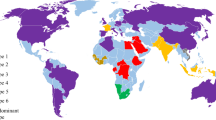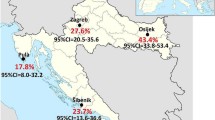Abstract
The hepatitis C virus infection (HCV) is the most frequent cause of hepatic infection in Europe. In Italy, anti-HCV positivity values are extremely variable, depending on the age and geographic location of the population being analysed. The aims of the study were: (1) evaluating positivity for anti-HCV antibodies in various age groups and determining the HBsAg in a mountainous and predominantly farming area in central Italy; (2) assessing some anamnestic and clinical variables through a questionnaire, submitted during the taking of blood samples, in order to determine HCV exposure and risk factors for the target population. 344 subjects selected by random sampling among 3308 people, older than 16, were considered as the target population. A prevalence study was carried out. The sources of data were: blood samples taken to carry out the HCV positivity test; a questionnaire including items about exposures at risk and case-historical and clinical patient data. The risk of infection was evaluated by a multiple logistic regression model. The inferred HCV+ prevalence rate is 22.4/100 (95% confidence interval (CI): 20.8–24.1). An increasing age trend is shown with a higher positive predominance among females (28.99/100 vs. 14.29/100 in males). The positive HBsAg prevalence in the examined survey is 1.2/100. Variables associated with the HCV occurrence are case history of pneumonopathy (OR: 4.9) and exposure to parenteral therapies with glass syringes (OR: 3.3). This study is consistent with literature about the hypothesis of a north-south geographic gradient in the hepatitis C occurrence in Italy. Data clearly show the effects of the inappropriate use of medical or surgery practices on the population, with particular reference to the use of glass syringes. No elements prove that the farming features of the area may be predictive of HCV infection risk. The extent of the recorded prevalence values calls for the implementation of programmes aimed at detecting clusters or population areas at risk.
Similar content being viewed by others
References
Trepo C, Pradat P. Hepatitis C virus infection in Western Europe. J Hepatol 1999; 31(Suppl 1): 80-83.
Ebeling F. Epidemiology of the hepatitis C virus. Vox Sang 1998; 74(Suppl 2): 143-146.
Williams I. Epidemiology of Hepatitis C in the United States. Am J Med 1999; 107(Suppl 6B): 2s-9s.
Alter MJ. Hepidemiology of Hepatitis C virus infection. Semin Liv Dis 1995; 15: 5-14.
Maggi G, Armitano S, Brambilla L, et al. Hepatitis C infection in an Italian population not selected for risk factors. Liver 1999; 19: 427-431.
Conte D, Fraquelli M, Prati D, Colucci A, Minola E. Prevalence and clinical course of chronic hepatitis C virus: Infection and rate of HCV vertical transmission in a cohort of pregnant women. Hepatology 2000; 31: 751-755.
Bellentani S, Tiribelli C, Saccoccio G, et al. and the Dionysos study. Prevalence of chronic liver disease in the general population of Northern Italy: The Dionysos study. Hepatology 1994; 20: 1442-1449.
Stroffolini T, Manchinelli M, Taliani G, et al. High prevalence of hepatitis C virus infection in a small central Italian town: Lack of evidence of parenteral exposure. Ital J Gastroenterol 1995; 27: 235-238.
Osella AR, Misciagna G, Leone A, Di Leo A, Fiore G. Epidemiology of hepatitis C virus infection in an area of Southern Italy. J Hepatol 1997; 27: 30-35.
Guadagnino V, Stroffolini T, Rapicetta M, et al. Hepatology 1997; 26: 1006-1011.
D'Amelio R, Stroffolini T, Matricardi PM, et al. Low prevalence of anti-HCV antibody among Italian air force recruits. Scand J Infect Dis (in press).
Albano A, Pianetti G, Biffi MR, et al. Prevalence of anti HCV in subjects of various age groups. Eur J Epidemiol 1992; 2(8): 309-311.
Chiaramonte M, Stroffolini T, Lorenzoni U, et al. Risk factors in community-acquired chronic hepatitis C virus infection: A case control study in Italy. J Hepatol 1996; 24: 129-134.
Kiyosawa K, Soderyama T, Tanaka E, et al. Interrelationship of blood transfusion, non-A, non-B hepatitis and hepatocellular carcinoma. Analysis by detection of antibody to hepatitis C virus. Hepatology 1990; 12: 671-675.
Ortona L, De Luca A. Valutazione clinica del paziente cronico sintomatico. In seminario di aggiornamento sull'epatite da HCV: Diagnosi, epidemiologia, prevenzione e terapia. ISTISAN. Gen. 1995.
Lau JYN, Davis GL, Kniffen J, et al. Significance of serum hepatitis C virus RNA levels in chronic hepatitis C. Lancet 1993; 341: 1501-1504.
Knodell AJ, Ishak KG, Black WC, et al. Formulation and application of a numerical scoring system for assessing histologycal activity in asymptomatic chronic active hepatitis. Hepatol 1981; 1: 431-435.
Zaaijer HL, Cuypers HTM, Reesinkh W, et al. Reliability of polymerase chain reaction for detection of hepatitis C virus. Lancet 1993; 341: 722-724.
Zaaijer HL, Vrielink H, Van der Poel CL, et al. New immunoblot resolves indeterminate results of antibody to hepatitis C virus. Transfusion 1994; 34: 184.
Van der Poel CL, Cuypers HTM, Reesinkh W, et al. Risk factors in HCV infected blood donors. Transfusion 1991; 31: 777-779.
Kao JH, Chen DS. Transmission of hepatitis C virus in Asia: Past and present perspectives. J Gastroenterol Hepatol 2000; 15(Suppl E91-6).
Sun CA, Chen HC, Lu CF, et al. Transmission of hepatitis C virus in Taiwan: Prevalence and risk factors based on a nationwide survey. J Med Virol 1999; 59: 290-296.
Mitsui T, Iwano K, Masuko K, et al. Hepatitis C virus infection in medical personnel after needlestick accident. Hepatology 1992; 16: 1109-1114.
Schneeberger PN, Keur I, van Loon AM, et al. The prevalence and incidence of hepatitis C virus infections among dialysis patients in the Netherlands: A nationwide prospective study. J Infect Dis 2000; 182: 1291-1299.
Kokado Y, Takahara S, Ikimaru N, et al. Clinical outcome of HCV infection after renal transplantation. Transplant Proc 2000; 32: 1940-1943.
Lunel F, Cadranel JF, Rosenheim M, et al. Hepatitis virus infections in hearth transplant recipients: Epidemiology, natural history, characteristics and impact on survival. Gastroenterology 2000; 119: 1064-1074.
Bzowej NH, Wright TL. Viral hepatitis and liver transplantation. J Gastroenterol Hepatol 1999; 14: S53-S60.
Klein RS, Freeman K, Taylor P, et al. Occupational risk for hepatitis C virus infection among New York city dentitis. Lancet 1991; 338: 1539-1542.
Baldo V, Floreani A, Menegon T, et al. Prevalence of antibodies against hepatitis C virus in the elderly: A seroepidemiological study in a nursing home and in an open population. The collaborative group. Gerontology 2000; 46: 194-198.
Van der Poel CL, Cuypers HTM, Reesinkh W. II virus dell'epatite C sei anni dopo. Lancet (ed. italiana) 1995; 12: 201-206.
Ohto H, Terazawa S, Sasaki N, et al. Transmission of hepatitis C virus from mothers to infants. N Engl J Med 1994; 330: 744-750.
Bresters D, Mauser-Bunschoten EP, Reesink HW, et al. Sexual transmission of hepatitis C virus. Lancet 1993; 342: 210-211.
Akahane Y, Kojima M, Sugai Y, et al. Hepatitis C virus infection in spouses of patients with Types C chronic disease. Ann Intern Med 1994; 120: 748-752.
Caporaso N, Ascione A, D'Antonio M, et al. Prevalence of anti-HCV among spouses and offspring of anti HCV positive subjects: An Italian multicentre study. J Gastroenterol 1995; 27: 5-7.
Zuckerman J, Clewley G, Griffiths P, Cockroft A. Prevalence of hepatitis C antibodies in clinical health care workers. The Lancet 1994; 343: 1618-1620.
Stevens CE, Taylor PE, Pindyck J, et al. Epidemiology of hepatitis C virus-A preliminary study in volunteer blood donors. Jama 1990; 263: 49-53.
SAS/STAT User's guide, Version 6, Fourth edition, Cary, NC: SAS Institute Inc, 1989.
Kaur S, Rybicki L, Bacon BR, Gollan JL, Rustgi VK, Carey WD. Performance characteristics and results of a large-scale screening program for viral hepatitis and risk factors associated with exposure to viral hepatitis B and C: Results of the National Hepatitis Screening Survey. National Hepatitis Surveillance Group. Hepatology 1996; 24(5): 979-986.
Istituto Nazionale di Statistica (ISTAT). Rapporto annuale 1999 (Capitolo 8: sanità, cambiamenti normativi e comportamenti dei cittadini). Istituto Poligrafico e Zecca dello Stato, 2000.
Author information
Authors and Affiliations
Rights and permissions
About this article
Cite this article
Raffaele, A., Valenti, M., Iovenitti, M. et al. High prevalence of HCV infection among the general population in a rural area of central Italy. Eur J Epidemiol 17, 41–46 (2001). https://doi.org/10.1023/A:1010932832190
Issue Date:
DOI: https://doi.org/10.1023/A:1010932832190




